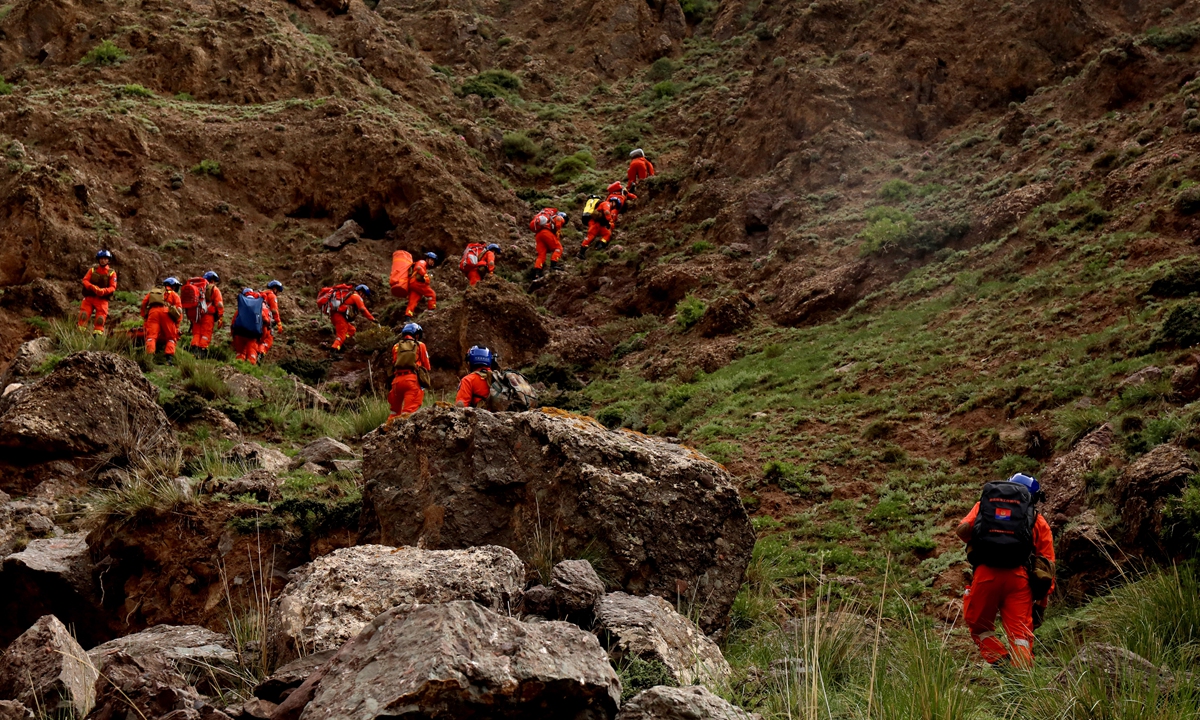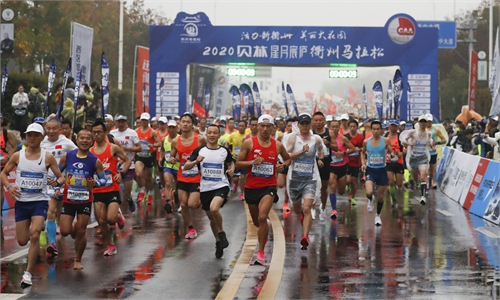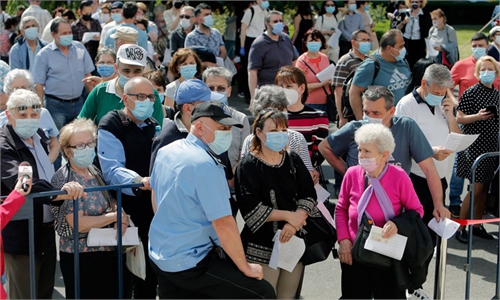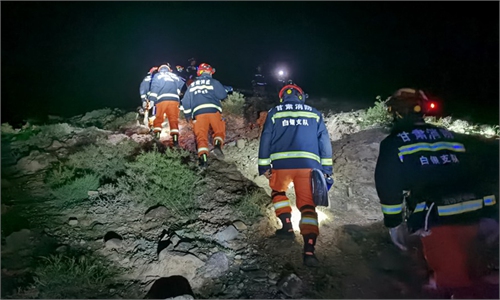21 died in ultramarathon tragedy in NW China due to extreme weather, lack of emergency preparation

Rescue team members searching for missing marathon runners in the Yellow River Stone Forest tourist site in Jingtai county, Baiyin, Northwest China's Gansu Province. Photo: Xinhua
In one of the deadliest tragedies in China's marathon competition history, 21 people were confirmed dead on Sunday due to extreme cold weather in a 100-kilometer mountain race held in Northwest China's Gansu Province, including two of the country's best long-distance runners.
Of all the 172 race participants, 151 have been confirmed safe with eight hospitalized but in stable conditions, while 21 were found dead, the People's Daily reported on Sunday.
Among the 21 dead, there are many well-known names in the field of trail running, including Liang Jing, Asia's point leader at International Trail Running Association (ITRA) and Huang Guanjun, China's top paralympic runner. Some insiders have called the day "the darkest day in China's trail running history."
Zhang Xuchen, mayor of Baiyin City, Gansu Province, apologized for the tragedy on Sunday and expressed deep condolences to the families of the victims. The local government has formed a team for an in-depth investigation on the cause of the incident. Other relevant parties are calling for lessons to be drawn from the tragedy to ensure the safety of ultramarathon event in the future.
As an event that has been held for three times in the past, questions are lingering online. Is the weather forecast of the event accurate enough for the race? Are emergency response plans adequate? If the organizers had called off the race or if athletes had quit soon after extreme weather hit, could the tragedy have been prevented?
Weather forecast
The unexpected extreme weather, including strong wind and freezing rain, is seen as the direct cause of the tragedy which occurred on Saturday. CCTV quoted rescuers as saying that low temperature was the biggest threat faced by the runners, since most wore thin clothes. As the weather suddenly changed, the temperature on the mountain had sharply dropped close to 0 degree Celsius.
One of the runners recalled online what he had experienced during the race. "The morning was breezy and sunny, and there was even a hint of warmth in front of the starting line," according the athletes. However, the weather changed abruptly afterwards.
After 10:30 am, 90 minutes into the race, the sporadic raindrops became dense. "The wind wrapped around the raindrops hitting my face like dense bullets, it really hurt. I couldn't open my eyes in the strong wind," recalled the runner who calls himself Liuluo Nanfang.
The extremely cold weather caused discomfort and hypothermia among marathoners, resulting in some losing communication and the race being suspended. Local authorities immediately organized multiple rescue forces to search for them.
More than 700 people were dispatched for the rescue operation, and a rescue command center was set up, the Xinhua News Agency reported on Sunday. But rescue work was challenging due to the complicated terrain at a height of some 2,000 meters, a further drop in temperature at night and poor communication signals in the mountains.
After the incident, many people questioned why such severe extreme weather had not been forecast in advance. Zhang Mingying, a weather expert from the Beijing Meteorological Bureau, pointed out that it was almost impossible to perfectly forecast such unusual situation.
The night before the race, the local meteorological bureau had already made a broad weather forecast and mentioned the possibility of short-time heavy precipitation, hail, lightning and high winds in the area. Early on the morning of the race, the weather bureau issued another notice that there would be significant temperature drop.
"With the current level of weather forecasting, the accuracy rate is high for a wide range," Zhang said, "but for small local extremes, and in mountainous areas with complex terrain, this is beyond the current level of weather forecasting."
Some critics have pointed out that in some top-level races hosted by developed countries, weather forecasts can be accurate even to the minute. In response, Zhang said this does not indicate that China's weather forecasting level is lower.
"China's forecasting level is basically comparable to that of developed countries when it comes to short-term weather forecasting," Zhang said, "in these top events, the courses are small and usually in plain areas, so it is relatively easy for weather broadcasts."
At the same time, Zhang also pointed out that the organizers of various events have different requirements for the accuracy of weather forecasts, which may also be the reason for the lack of accurate weather forecasts for this event.
"For events like rallies and off-road races, extreme weather is part of the competition, so it is likely that the organizing committee did not require a very accurate weather forecast," Zhang said.
Responsible for the weather forecast of this event is the county-level weather station.
Lin Ao, a runner who participated in the race, recalled to China Youth Daily that in the previous years of the event, extreme weather rarely occurred. One year the track temperature was around 25-30 degrees Celsius, and another it was almost 35 degrees Celsius.
Late May is supposed to be late spring and early summer in northern China, and the weather fluctuates a lot, Zhang said. "Although this event has not experienced extreme weather in previous years, possible extreme weather should be taken seriously," Zhang commented.
Organizing flaws
Many veteran marathoners pointed out to the Global Times that the sudden weather extremes do not prove that the race itself was bad, but the subsequent rescue was a test for the race organizers, which the organizers in Gansu failed to some extent.
When organizing a race in such a high-altitude place with a complex terrain and a changing weather, the organizers should have first ensured the safety of the athletes, Chen Penbin, China's top ultramarathon runner, told the Global Times on Sunday.
"In addition to the weather changes, the organizers should also consider that whether contestants from lower altitude places can adapt to the race held at an altitude of more than 2,000 meters," Chen said. "Whether they have been tested and trained in advance, these are the issues that the organizers need to consider."
The readiness of the rescue was also an issue. "When designing ultramarathon route on a mountain, if the runners need rescue, is the rescue route clear? Is there transportation to reach the rescue point quickly?"
According to some runners' recollections, the most difficult part of the course was from checkpoint 2 to checkpoint 3. This section had a distance of eight kilometers and a climb of 1,000 meters, and many sections were steep, requiring runners to climb up on their hands and knees.
"Because it was impossible to get to checkpoint 3 with a motorcycle, at checkpoint 3, the organizers did not provide any supplies. Contestants could not even take a break, or even quit the race here," wrote Liuluo Nanfeng.
Reports indicate that most of the participants who died perished on this segment. Many runners experienced hypothermia on the trail.
Another experienced marathon runner, organizer and friend to many deceased contestants surnamed Gong believed that extreme weather is not the main reason for the tragedy, but the key is that the organizing committee was not well prepared.
"This is not the worst race weather. It is very common that a trail running race starts in sunny weather and then sees a storm. But this time, the organizing committee failed to respond in time," Gong told the Global Times.
Based on the current information, they don't have a plan to deal with a large number of runners suffering hypothermia, which should be one of the race protection programs, Gong noted.
Because Baiyin has entered early summer season, the organizers did not require participants to bring a rash jacket and an insulation layer, which Gong believes is a reflection of the organizers' unprofessionalism.
For this kind of event with various risks, the organizer must do a thorough emergency filing plan. As the filing is expensive, and the vast majority of filings will not be enabled, so many organizers will choose to cut it, Gong said. "It's all a gamble, betting on that there won't be an emergency."
Lessons to learn
In recent years, trail running race is getting popular in China with more places hosting the event, many fraught with unknown risks and occasional casualties.
This is at least the third off-road racing event involving casualty in China in May. On May 4, a runner died of hypothermia during a 500-kilometer trail run in the Wumeng Mountains of Southwest China's Yunnan Province. On May 6, a company manager died of cardiac arrest while participating in the Gobi Challenge at the border of Northwest China's Gansu Province and Xinjiang Uygur Autonomous Region.
On Sunday afternoon, a 10 km women's trail running in East China's Zhejiang Province was called off by the organizers out of an emergency, saying "the roads were muddy due to the rain and some runners had withdrawn from the race."
Top trail running contestant Chen Penbin told the Global Times that since trail running is a relatively new sport to China, most of the domestic organizers lack experience, and often just pursue difficult environments while the course design is unreasonable, and the logistical support for the runners is not up to date.
Su Ziling, ITRA's representative at the Chinese mainland also pointed out that the current trail running tournaments organized in China usually neglect the practical and rapid rescue and emergency system, as well as hold "backward thinking" in the operation of marking and insurance, The Paper reported.
Industry insiders urge that cross-country marathon events must undergo stricter approval before they can be held.
In 2020, the State General Administration of Sports updated the Measures for the Management of Sports Event Activities, indicating that the Administration no longer reviews sports event activities, except for international or special events, leaving most of the locally held events up to local authorities to approve.
According to data provided by the China Athletics Association, the number of marathon-related events held in China each year in recent years is close to 2,000. Extreme events such as mountain trail running are also counted among them.
Some runners said that in most of the cross-country events they participate in, the course design poses great dangers. A runner told China Youth Daily, "mountain cross-country events must be separated from the marathon for approval. There must be a professional cross-country team to survey, and the dangerous sections must be prepared with emergency plans."



